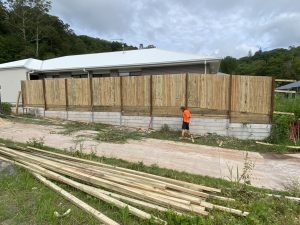Timber Fencing Frequently Asked Questions
Choosing a fence for your home or business property is a long-term investment, so making sure you choose the right option to meet your needs is important. Driving factors should not only include the cost of the material and installation but should also include longevity, maintenance intervals, effort, and cost of upkeep. Before putting up a fence, make sure you know what you are liable for in both its installation and upkeep. Below we answer some commons questions asked by property owners who wish to increase property value, improve privacy, and decrease noise by adding or replacing a fence.

Does your neighbour have to pay for half of the dividing fence in Queensland?
If it is built on the collective boundary line, a property dividing fence is owned equally by the neighbours of the adjoining properties. Neighbours should contribute equally to the building and maintaining of the dividing fence and should not alter or attach structures such as carports, clothing lines, or shade sails unless agreed.
If the fence or part thereof is built on one neighbour’s land, it belongs to that neighbour, even if both parties contributed to the construction. If one neighbour wants a more expensive fence than what is needed to meet requirements, they will be liable for the additional costs and maintenance.
Neighbours are generally not jointly responsible for retaining walls since they serve a different purpose and are (mostly) of more benefit to one neighbour in supporting excavated or built-up soil.
How high above a retaining wall may I build my fence?
A fence does not require building approval as long as it is not higher than two metres from the actual ground surface. Fences, as well as combined retaining wall and fence constructions that are higher than two metres, will require approval.
What timber is best for a fence?
Treated pine is one of the best types of timber to use for fencing. Not only is it cost-effective, but it is pressure treated to protect against fungal decay, rot due to aging, and prevent insect and termite damage.
How long can I expect my timber fence to last?
The general life expectancy of a good quality timber fence is 15 years with minimal upkeep. However, this can be extended for over 20 years when putting a little more effort into the maintenance. Untreated timber won’t last longer than seven years. Although this will be cheaper and can be treated oneself, home applications don’t penetrate as deeply as professionally pressure-treated types, and therefore don’t provide the same protection.
How do I maintain a timber fence?
To maintain your timber fence and ensure it lasts a long time, replace rotting boards or posts as soon as possible and secure or replace loose and missing nails or screws. If your fence posts look crooked it could be due to erosion, rot, or poor footing. Wood that starts showing signs of wear should be stained or painted. When doing this, make sure to follow the preparation steps before applying the treatment as this will be significant in how effective the application ends up being.
Is treated pine or hardwood better for fencing?
Unlike hardwood, treated pine is created to resist termites. If the timber will be exposed to soil, there is no question that treated pine will last longer. It won’t be affected by termites, nor will it rot quickly.
Is it better to paint pressure-treated wood or to stain it?
It is advisable to stain pressure-treated wood. Preservatives in treated wood can make it hard for paint to bond. In addition, wet or damp timber can affect how well paint adheres to the wood. Painting will require extra preparation, and if this preparation is skipped, the protection won’t be very effective.
Looking for a free quote for your property?
